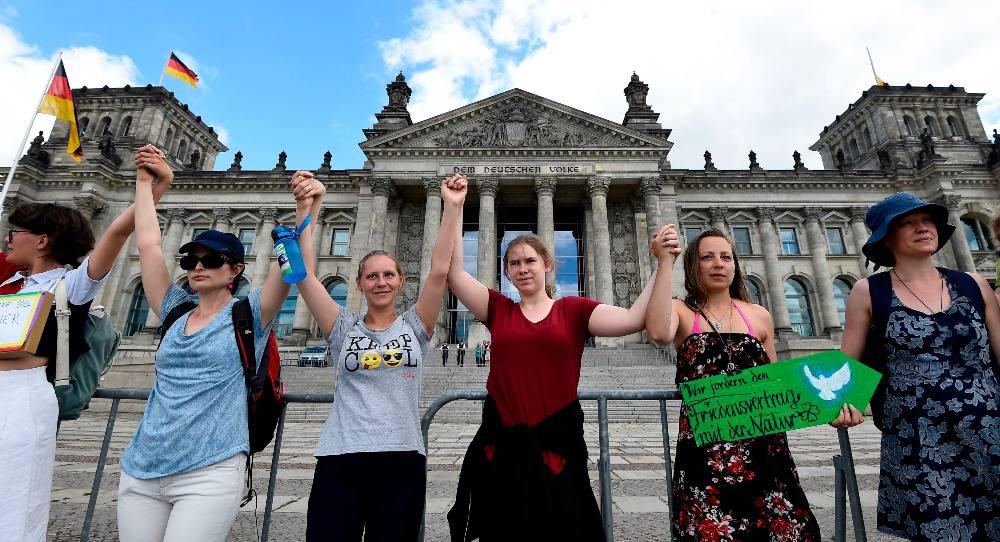The EU supports the race to net zero, the process aimed at reaching carbon neutrality by 2050. The net zero goal means that the EU, like the rest of the international community, seeks to emit no more greenhouse gas emissions than can be absorbed.
To achieve this, the EU will work on cutting emissions as swiftly as possible from energy, industrial, and housing sectors, while investing into “offsetting” strategies that allow for greenhouse gas absorption—either through technological or natural means.
There is a hidden danger in the race to net zero: stalling and banking on technological innovations that do not yet exist, such as carbon capture systems or geo-engineering, whose impacts on living systems we cannot anticipate. These traps are currently included in all climate transition strategies, including those of the EU, whose effects are projected to be critically underwhelming.
With the latest round of pledges after U.S. President Joe Biden’s Global Leaders’ Summit in April 2021, it is still estimated that the world is on track for a minimum of a 2.4 degrees Celsius increase by the end of the century. Let’s not forget, too, that these are pledges and that transition implementation plans are still extremely blurry all around the world.
The EU has taken more concrete steps than many other countries and regions toward a planned transition, but there are still too many inconsistencies in the current measures. If the EU is to claim a true leadership position, it must step up its efforts on multiple fronts.
To start with, the EU cannot claim climate leadership as long as it continues to subsidize fossil fuel industries. In July 2020, Investigate Europe identified that EU member states still subsidize the fossil sector by more than €137 billion ($167 billion) per year in the form of direct subsidies, tax breaks, and exemptions.
Proclaiming climate leadership on the international scene while being unable to openly address this level of subsidies is dangerous, apart from being hypocritical. And this, in addition to the EU’s push for the hydrogen strategy, which may risk leading towards more fossil exploitation. The EU is teetering toward high reputational damage.
The union is currently working on introducing a carbon border adjustment mechanism (CBAM) compatible with World Trade Organization (WTO) rules to avoid carbon leakage. But some non-EU countries see this as a protectionist move to keep European industries more competitive while continuing to rely on fossil energy on the road to decarbonization.
Making the CBAM WTO-compatible is a matter of legal technicality. The bigger challenge is that of building trust with other nations around the world. This trust is currently absent.
As seen at the latest Petersberg Climate Dialogue organized by Germany, the EU continues to fall short of meeting its commitments in terms of climate finance and support for less developed economies’ transitions and adaptation.
The EU is therefore pursuing potentially economically risky measures. It is also failing to provide the support necessary to ensure that climate transitions are ushered in confidently around the globe.
An equally concerning loophole can be found in the EU’s taxonomy for sustainable investments.
The taxonomy is closely monitored around the world as an advanced normative framework designed to guide private sector investments and reduce economic risks. While it does not prevent investments in climate-damaging sectors, it will, over time, create incentives that harness the financial and economic power of the private sector, enabling a full transition.
The EU’s taxonomy for sustainable investments is therefore a critical pillar of the EU’s climate leadership, with a potential Brussels effect that will extend the taxonomy’s impact far beyond Europe’s borders.
Considering the importance of this instrument, it is of particular concern that biofuels are included in the taxonomy when they contribute to deforestation and the decimation of old growth forests.
This is a typical trap of the logic behind net zero: you can emit as long as you offset. But offsetting strategies are not based on logical ecological accounting. They often lead to more climate damage as well as other ecological breakdowns.
These inconsistencies, among many others, create a hollow ring to some of the EU’s most advanced measures for climate action. The union’s rhetoric fails to match the urgency of the situation.
Of course, we live in the age of wicked complexity: there is no easy way to transition whole economies safely from a fossil-based system into a different type of power generation while maintaining democratic rhythms and a stable international system that has grown out of economic interdependencies. The EU is currently banking on incremental change, but the truth is, the world simply cannot afford timid action.
One sign of hope came from Germany last week.
A constitutional court ruling based on inter-generational justice ruled that current climate measures are insufficient to ensure a truly safe future for incoming generations. The court urged the government to step up its climate ambitions and quickly establish an actionable plan for implementation.
This ruling comes during an election year for Germany, in which the Greens are currently running high in the polls. It demonstrates, more than anything, that democratic systems are expected to produce change quickly.
This ruling, and its direct implementation, will resonate beyond Germany. If Germany revises its Recovery and Resilience Plan (RRP) accordingly, the face of climate action will change within Europe. Just as importantly, global trust in European leadership on climate action and on democracy will be restored.
In short, climate leadership will require more democratic action at the national level. It will require precise and ambitious RRPs. It will require fixing inconsistencies within regulatory frameworks. And it will require intensifying climate cooperation with less developed economies. The facts speak for themselves.




-1.png)

-1.png)